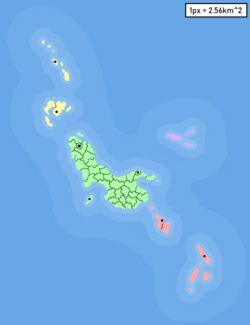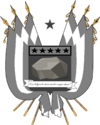Flatstone
De Republikken Flatstein The Republic of Flatstone | |
|---|---|
| Motto: "En bølgende stein samler ingen mose." | |
| Anthem: The Rock Cycle Song | |
 | |
| Capital and largest city | Shale |
| Official languages | Norwegian English |
| Ethnic groups | Stoenian |
| Demonym(s) | Stoenian Steinmann (Norwegian) |
| Government | Full Presidential Republic |
| President Leif Erockson | |
| Dwain Jonsin | |
| Legislature | The Congress of Flatstone |
| Formed | |
• established by rogue pillagers | September 21st 1791 |
| Area | |
• Total | 22,662 km2 (8,750 sq mi) |
| Population | |
• 2019 estimate | 5,600,000 |
• 2010 census | 5,443,412.4 |
• Density | 247.1/km2 (640.0/sq mi) |
| GDP (PPP) | 2018 estimate |
• Total | $0.45 Trillion |
• Per capita | $51,461.95 |
| GDP (nominal) | 2018 estimate |
• Total | $455.3 Billion |
• Per capita | $51,461.95 |
| Gini (2018) | 24.9 low |
| HDI (2018) | very high |
| Currency | Silver Stone (SVST) |
| Time zone | UTC-2 (PST) |
• Summer (DST) | UTC-2 (not observed) |
| Driving side | left |
| Calling code | +224 |
| Internet TLD | .rock |
Government
Demographics
History
The history of Flatstone began on the 21st of September, of 1791. When one of the four nomadic pillager groups settled onto an island in the middle of the Marmor Sea. This group called themselves the "Livløs", and spoke only Norwegian. They had a small force of around 400 men, although once 2,000 strong, countless failed attempts at pillaging had resulted in their dwindling numbers. These men had decided that enough was enough, and now that they had become a known threat, they had no other place to run but the inhabited island located in the middle of the Marmor Sea. Three years had past by the time any civilization was established, and by 1794, an estimate of five small towns/settlements were established across the northwest part of the island when another one of these nomadic pillager groups had recieved word about the recently discovered uninhabited island, and they saw an oppurtunity. The next tribe to arrive on the island established their first settlement on the southeat part of the island, and laid claim to some of the coastal islands further west. These would be come to known as the "Bergensere", and were infamous to foreign nations for being ruthless and unforgiving. Although they had an advantage over the Livløs, and that advantage was numbers. The Bergensere had not taken as many losses as the Livløs had in previous raids because of superior experience and equipment.
Both tribes would go on to expand into the eastern territory, with the Bergensere expanding a small distance to the west, and the Livløs expanding a small distance to the south. But before the entire southwest could be annexed by the two growing tribes, the Livløs split into two because of a system of monarchy that they had established, giving the leaders of the Livløs clan the majority of the supplies that their people desperately needed. The third tribe that would emerge would call themselves the "Frigjørere", or Liberators. The Frigjørere and the Livløs would be involved in multiple border clashes over the course of two years, even though they were fighting a war of attrition without supply to feed their men, let alone their people. These clashes would take place through 1797-1799, and would results in the deaths of around 3,000 people, civillians and pillagers alike. These clashes are remembered as the "Breen Mountain Conflicts". By 1801, the Bergensere would have taken all of the western islands, and expanded halfway into the north, along with into one of the settlements that had been built by the Frigjørere. After three more years of constant stalemates, a fourth pillager clan arrived in the northeast after foreigners from the nation of Fallooplesburg has seeked religious refuge and safety from the war that was going on in 1804. Although because of the Bergenseres superior equipment, experience and numbers, they had been invaded and annexed by the Bergensere by 1806, with many of their citizens massacred during conflict. This would give the Bergensere a giant advantage over the other two nations that had already been starved of both men and supplies because of multiple conflicts internally and between eachother. Preparations for war were made with the other two tribes throughout 1806 and 1807, as the Bergensere aimed to let the settlements that were massacred in 1805 recover, and by mid 1808, the invasions had begun into the south of the Frigjørere Clan, but with the large army of the Bergensere marching through every settlement, met with almost no resistance, the Frigjørere was unable to react, and collapsed under the pressure of the Bergensere.
The Livløs were dumbfounded at the sight of the Bergensere Clan being able to wipe out an enemy that the Livløs couldn't beat in 11 years, and they were in no way prepared to face the army of 6,000 men marching into their cities at alarming rates, their men were squashed like bugs by August of 1809, and by 1810, the leaders of the Livløs tribe had already been publicly hanged. The Bergensere had succesfully reunited the province of what would now be known as Flatstone under one rule, after 13 years of Civil War. This conflict would come to be known as the Flatstone Civil War.

